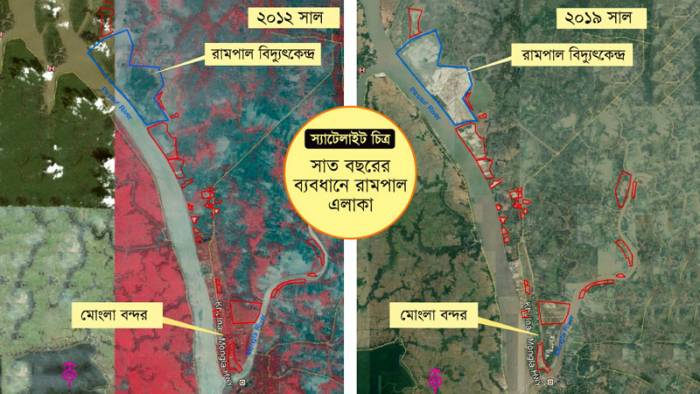
Think of a large mangrove forest, spread across two countries, home to the mighty Royal Bengal tigers, the threatened Ganges River Dolphin, and many other species of animals. . Millions of people depend on it for survival. The forest acts as a natural barrier against cyclonic storms. It has been the protector deity for people in Bangladesh and India for many a time. This is the story of Sundarbans forest.
In August 2011, Bangladesh’s Power Development Board (BPDB) and India’s state-owned National Thermal Power Corporation (NTPC) signed a memorandum of understanding to develop the Rampal coal plant near Sundarbans forest. The Rampal coal plant is being built on an area of over 1834 acres of land, which was mainly fertile farming land and fish ponds. The land was forcefully acquired from farmers. Those who led protests against the project faced prosecution from the state and ruling party cadres.
Civil society in Bangladesh has been vocal against their opposition to the Rampal coal plant project and has led marches, hartals, cycle rallies and have continued their lobbying efforts with UNESCO to list Sundarbans forest as a heritage site in danger. Due to their efforts, three french banks and two Norweigan pension funds ruled out funding the project in 2015. Then Export-Import Bank of India bankrolled the whole project and loaned USD 1.6 billion to BIFPCL, in essence, financing the entire project debt.
An Achilles Heel for the Bangladesh government
The Rampal coal plant is like the Achilles Heel of the Bangladesh government. Ever since it browbeat opposition to its goal to build the 1320MW coal plant in Sundarbans, a UNESCO heritage site, it has faced questions repeatedly at the international level, facing protests wherever it went. The latest in this saga is the intervention of the US Special Envoy on Climate John Kerry. During his visit to Bangladesh in April to invite the Prime Minister to the Leaders Summit on Climate, John Kerry said that he was confused at Bangladesh’s stance concerning the Sundarbans. On the one hand, it is taking steps to protect the forest, and on the other, it is taking up projects like the Rampal coal-fired power plant. How is this possible, he asked.

The area around the Rampal coal plant is already witnessing the loss of vegetation even before the plant has been built. Photo: https://bonikbarta.net/
There cannot be a better time to cancel the Rampal coal plant than it is now. As the Bangladesh government is reviewing its energy master plan and deliberating on cancelling all the major coal projects in the pipeline, Rampal coal plant should be also on the list. Young people in Bangladesh have also launched the Green New Deal campaign, calling on the government to cancel all coal power plant projects and use the land to kickstart new solar energy projects to move towards a 100% renewable energy system by 2050.
This one step will seal the fate of the Sundarbans, the world’s largest mangrove forest and a UNESCO heritage site. As dirty coal is on a steady decline worldwide and renewable energy is taking its place, there shouldn’t be any question about the timing. Reports after reports have shown that the Rampal coal plant will be a burden for Bangladesh and its people. The Rampal coal plant is fraught with unacceptable hazards and out of step with the times. Bangladesh will do well without another coal plant.


0 Commentaires